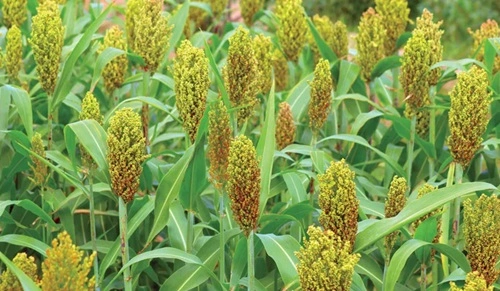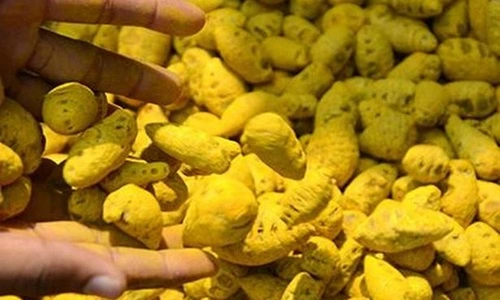Sorghum, commonly known as “Jowar” in India, is a major cereal crop grown for grain, fodder, and industrial uses. It is a staple food for millions and a vital crop in dryland agriculture due to its exceptional ability to withstand drought, heat, and low soil fertility. Sorghum provides essential nutrients, including carbohydrates, protein, fiber, and micronutrients like iron and phosphorus, making it crucial for food security and livestock feed.
India is one of the largest producers of sorghum globally, with cultivation spread across Maharashtra, Karnataka, Andhra Pradesh, Madhya Pradesh, Tamil Nadu, Rajasthan, and Gujarat. Sorghum is cultivated in Kharif (rainy season) and Rabi (post-rainy season). Farmers now have access to improved sorghum varieties with higher yields, disease resistance, and suitability for specific uses like grain, fodder, and biofuel production.
This article highlights more than 10 top sorghum varieties in India, their characteristics, cultivation regions, and specific uses.

1. CSH 14
CSH 14 is one of the most widely cultivated hybrid sorghum varieties in India, valued for its high grain yield and adaptability.
- Type: Hybrid
- Maturity: 100–110 days (Kharif season)
- Regions: Maharashtra, Karnataka, Andhra Pradesh
- Characteristics:
- High grain and fodder yield
- Resistant to shoot fly and stem borer
- Medium-height plants with compact panicles
- Uses: Grain for food, dual-purpose (fodder and grain)
2. CSH 16
CSH 16 is a popular hybrid variety known for its quick maturity and drought resistance.
- Type: Hybrid
- Maturity: 95–100 days
- Regions: Karnataka, Maharashtra, Gujarat, Rajasthan
- Characteristics:
- High resistance to drought and pests
- Ideal for dryland and rainfed regions
- Uses: Grain for human consumption, fodder
3. CSV 15
CSV 15 is a widely grown open-pollinated variety (OPV) developed for grain production in arid zones.
- Type: Open-pollinated
- Maturity: 100–110 days
- Regions: Maharashtra, Gujarat, Rajasthan, Tamil Nadu
- Characteristics:
- Drought-tolerant and adaptable to poor soils
- High-yielding with bold grains
- Uses: Food grain, fodder
4. CSV 20
CSV 20 is a high-yielding sorghum variety suitable for both Kharif and Rabi seasons.
- Type: Open-pollinated
- Maturity: 110–115 days
- Regions: Maharashtra, Karnataka, Andhra Pradesh
- Characteristics:
- High grain yield with strong stalks
- Tolerant to grain mold and shoot fly
- Uses: Dual-purpose (grain and fodder), silage
5. CSV 23
CSV 23 is an improved variety of sorghum developed for grain quality and resistance to major pests.
- Type: Open-pollinated
- Maturity: 100–110 days
- Regions: Tamil Nadu, Gujarat, Madhya Pradesh
- Characteristics:
- High tolerance to diseases like grain mold
- Good for rainfed and irrigated conditions
- Uses: Grain for food, fodder for livestock
6. CSH 25
CSH 25 is a high-yielding hybrid sorghum variety developed for grain and fodder production.
- Type: Hybrid
- Maturity: 100–105 days
- Regions: Andhra Pradesh, Maharashtra, Karnataka
- Characteristics:
- High biomass and grain yield
- Good resistance to shoot fly and stem borer
- Uses: Dual-purpose (grain and fodder), silage production
7. Phule Vasudha
Phule Vasudha is a multi-cut forage sorghum variety developed for fodder production in dryland regions.
- Type: Multi-cut forage variety
- Maturity: 85–90 days (first cut)
- Regions: Maharashtra, Karnataka, Gujarat
- Characteristics:
- High green fodder yield
- Resistant to lodging and drought
- Uses: Livestock fodder
8. SSV 84
SSV 84 is a sweet sorghum variety grown for its high sugar content and biomass production.
- Type: Sweet sorghum
- Maturity: 100–110 days
- Regions: Maharashtra, Tamil Nadu, Karnataka
- Characteristics:
- High juice yield with high sugar content
- Suitable for biofuel and jaggery production
- Uses: Biofuel (ethanol), jaggery, silage
9. CSH 30
CSH 30 is an improved hybrid variety suitable for grain and fodder production.
- Type: Hybrid
- Maturity: 100–105 days
- Regions: Maharashtra, Karnataka, Gujarat
- Characteristics:
- High yield potential and good grain quality
- Tolerant to grain mold and lodging
- Uses: Food grain, livestock feed
10. CSV 44F
CSV 44F is a high-yielding forage sorghum variety developed for single-cut fodder production.
- Type: Forage variety
- Maturity: 80–85 days
- Regions: Karnataka, Tamil Nadu, Gujarat
- Characteristics:
- High biomass yield with excellent fodder quality
- Resistant to drought and lodging
- Uses: Livestock fodder, silage
FAQs
Q1: Which sorghum variety is best for grain production?
A: CSH 14, CSH 16, and CSV 15 are ideal for grain production due to their high yields and adaptability.
Q2: Which sorghum variety is best for fodder production?
A: Phule Vasudha, CSV 44F, and CSH 25 are excellent for fodder production.
Q3: What is sweet sorghum, and which variety is recommended for biofuel?
A: Sweet sorghum is grown for its high sugar content used in ethanol production. SSV 84 is widely recommended for biofuel production.
Q4: Which sorghum variety is suitable for rainfed conditions?
A: CSV 20, SPV 462, and CSV 15 perform well in rainfed and semi-arid regions.
Q5: What is the maturity period of most sorghum varieties?
A: Sorghum varieties mature within 100–110 days depending on the type and growing season.
Conclusion
India’s diverse climate and the need for sustainable, low-input agriculture make sorghum cultivation an essential part of the farming landscape. With varieties like CSH 14, CSV 15, Phule Vasudha, and SSV 84, farmers can choose from high-yielding, drought-tolerant, and multi-purpose sorghum varieties suited for grain, fodder, and biofuel production. By adopting these improved varieties, farmers can enhance productivity, profitability, and resilience to climate challenges.

